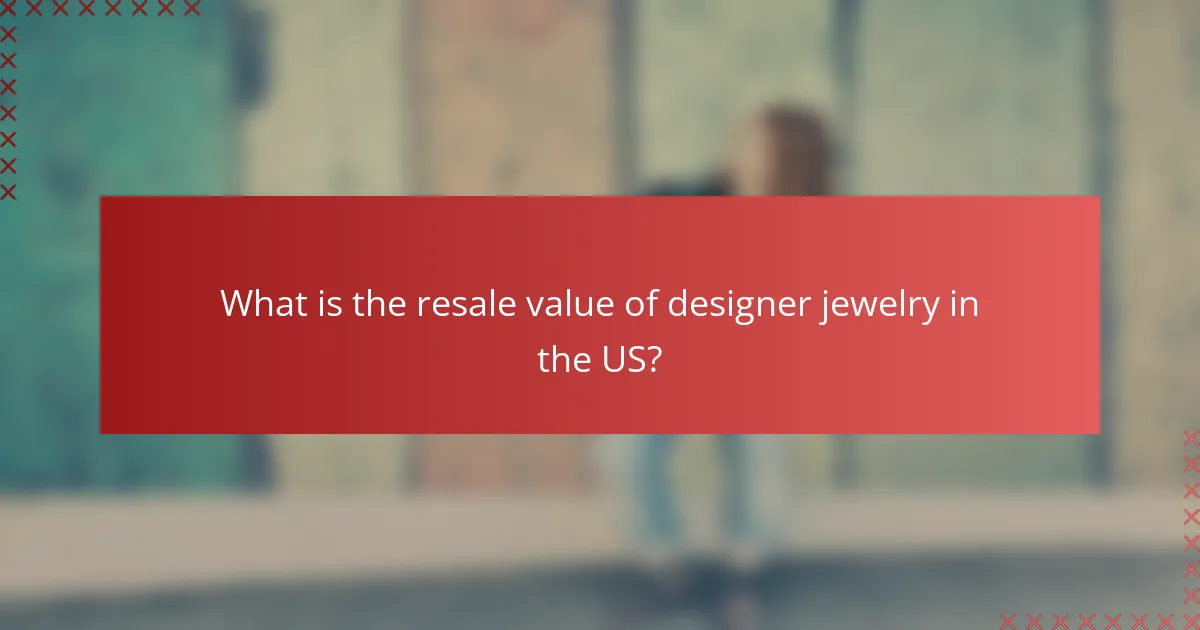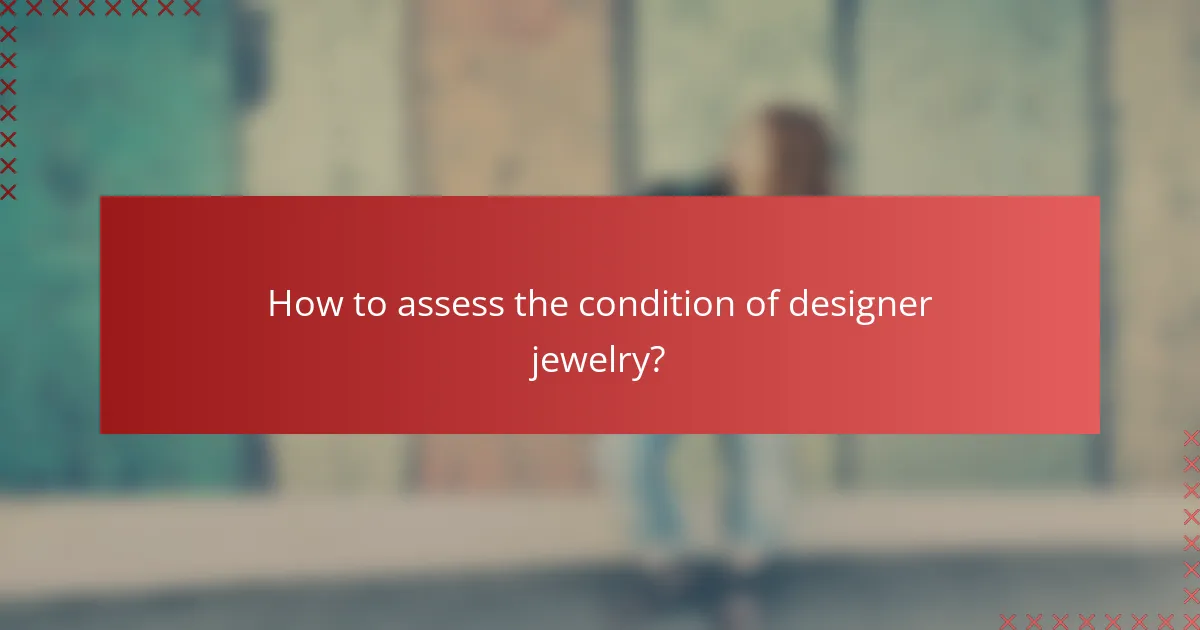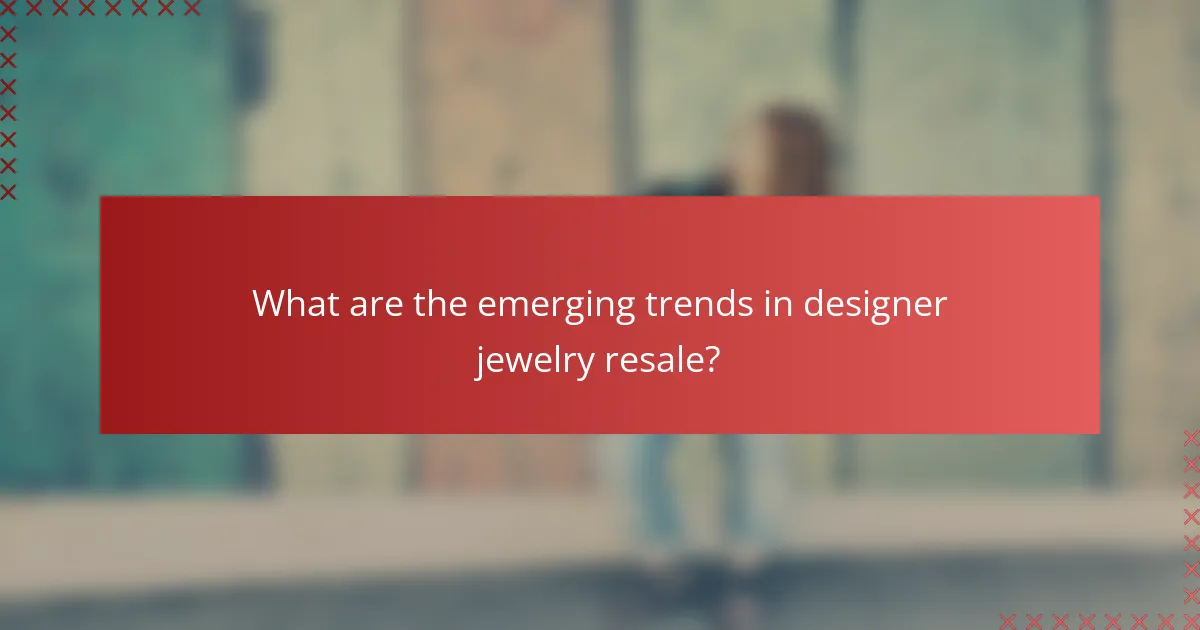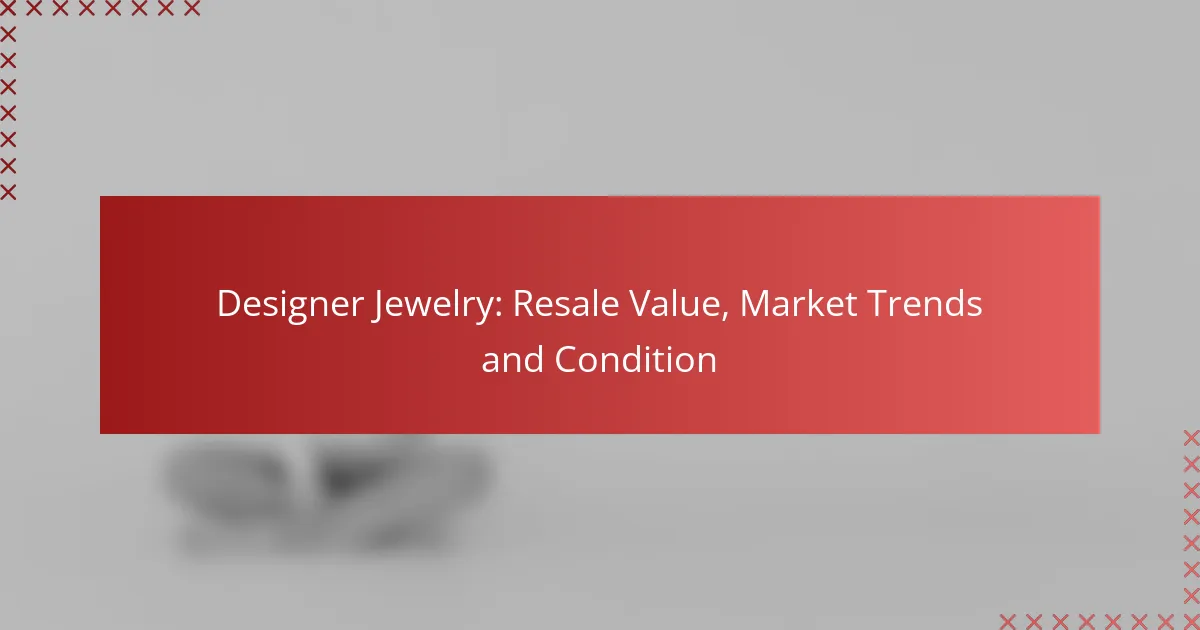Designer jewelry holds a unique position in the market, with its resale value heavily influenced by brand reputation, condition, and current market trends. High-quality pieces from renowned designers can often retain 50% to 80% of their original price, making them a worthwhile investment. Additionally, factors such as consumer preferences and economic conditions can lead to significant fluctuations in demand and pricing for pre-owned items.

What is the resale value of designer jewelry in the US?
The resale value of designer jewelry in the US can vary significantly based on brand, condition, and market demand. Generally, high-quality pieces from well-known brands can retain a substantial portion of their original retail price, often ranging from 50% to 80% of the initial cost.
Factors affecting resale value
Several factors influence the resale value of designer jewelry, including brand reputation, rarity, and condition. Jewelry from prestigious brands tends to have higher resale values due to their established market presence and desirability.
The condition of the piece is crucial; items that are well-maintained, with original packaging and documentation, typically fetch higher prices. Additionally, market trends can impact resale value, as certain styles or materials may become more sought after over time.
Top brands with high resale value
Some designer jewelry brands are known for their exceptional resale value, including Cartier, Tiffany & Co., and Van Cleef & Arpels. These brands often maintain a loyal customer base and are recognized for their craftsmanship and timeless designs.
For example, Cartier’s Love bracelet and Tiffany’s engagement rings frequently sell for a significant percentage of their original prices, making them popular choices for resale. Investing in pieces from these brands can be a strategic move for those looking to retain value over time.

How do market trends impact designer jewelry resale?
Market trends significantly influence the resale value of designer jewelry by affecting demand and pricing. Factors such as consumer preferences, fashion cycles, and economic conditions can lead to fluctuations in how much buyers are willing to pay for pre-owned pieces.
Current trends in luxury jewelry
Luxury jewelry trends often reflect broader fashion movements and cultural shifts. Currently, there is a growing preference for sustainable and ethically sourced materials, which can enhance the resale value of pieces that meet these criteria. Additionally, vintage and retro styles are gaining popularity, making older designer items more desirable.
Another trend is the rise of personalized and custom jewelry, which appeals to consumers looking for unique pieces. This trend can impact resale values, as one-of-a-kind items may command higher prices in the secondary market.
Impact of economic conditions on resale
The economic climate plays a crucial role in the resale market for designer jewelry. During economic downturns, luxury goods often see a decline in demand, which can lower resale prices. Conversely, in a robust economy, consumers may be more willing to invest in high-end jewelry, driving up prices.
Inflation and changes in disposable income also affect how much buyers are willing to pay. For instance, during periods of high inflation, consumers may prioritize essential purchases over luxury items, impacting resale values negatively. Sellers should consider these economic indicators when determining the best time to sell their jewelry.

What condition factors affect designer jewelry pricing?
The condition of designer jewelry significantly influences its pricing, with factors such as authenticity, wear and tear, and overall presentation playing crucial roles. Buyers typically seek pieces that are in excellent condition, complete with original packaging and documentation, which can enhance resale value.
Importance of authenticity and certification
Authenticity is paramount in determining the value of designer jewelry. Pieces that come with certification from reputable sources, such as the brand itself or recognized appraisers, are generally more sought after and command higher prices. For example, a certified diamond from a well-known jeweler can fetch tens of percent more than a similar, uncertified stone.
When buying or selling designer jewelry, always verify the authenticity through documentation. Look for original receipts, certificates of authenticity, and brand-specific markings, as these elements can significantly impact resale value.
Role of wear and tear on value
Wear and tear can drastically reduce the value of designer jewelry. Signs of damage, such as scratches, missing stones, or tarnishing, can lead to a lower appraisal. Jewelry that has been well-maintained and shows minimal signs of use will typically retain its value better than heavily worn items.
To preserve the value of your designer pieces, consider regular maintenance, such as professional cleaning and repairs. Avoid exposing jewelry to harsh chemicals or environments that could cause damage, and store pieces properly when not in use to minimize wear.

How to assess the condition of designer jewelry?
Assessing the condition of designer jewelry involves examining its physical state and identifying any signs of wear or damage. A thorough evaluation can significantly impact its resale value and marketability.
Visual inspection techniques
Start with a close visual inspection of the jewelry. Look for scratches, dents, or discoloration on the metal and gemstones. Use a magnifying glass to check for any imperfections that may not be visible to the naked eye.
Pay attention to the clasp and settings, ensuring they are secure and functioning properly. A loose stone or broken clasp can diminish the piece’s value. Document any visible flaws, as these details are crucial for potential buyers.
Professional appraisal services
Engaging a professional appraiser can provide an expert assessment of your designer jewelry’s condition. Appraisers typically evaluate the piece based on criteria such as craftsmanship, materials, and overall wear, which can help establish its market value.
Look for certified appraisers who adhere to recognized standards, such as those set by the American Society of Appraisers or the International Society of Appraisers. Their expertise can guide you on whether to repair or sell the jewelry as-is, depending on its condition and potential resale value.

What are the best platforms for reselling designer jewelry?
The best platforms for reselling designer jewelry include online marketplaces and consignment shops, each offering unique advantages. Choosing the right platform depends on factors like convenience, fees, and target audience.
Popular online marketplaces
Online marketplaces such as eBay, Etsy, and Poshmark are popular choices for selling designer jewelry. These platforms allow sellers to reach a broad audience, often resulting in quicker sales. Listing fees and commission rates vary, so it’s essential to review each platform’s terms before committing.
For example, eBay charges a final value fee of around 10-12% on sales, while Poshmark takes a flat commission on sales over a certain amount. Sellers should also consider the platform’s user base and how it aligns with their jewelry’s style and price range.
Benefits of consignment shops
Consignment shops provide a hands-off approach to selling designer jewelry, as they handle the sales process for you. These shops typically take a percentage of the sale, which can range from 20-50%, but they often have established customer bases and can market your items effectively.
Additionally, consignment shops may offer personalized service, helping to assess the jewelry’s value and setting appropriate pricing. However, it’s important to ensure that the shop has a good reputation and a history of successful sales to maximize your returns.

How to prepare designer jewelry for resale?
Preparing designer jewelry for resale involves cleaning, proper packaging, and presenting the item attractively. These steps enhance the jewelry’s appeal and can significantly impact its resale value.
Cleaning and maintenance tips
Before reselling, ensure the jewelry is clean and well-maintained. Use a soft cloth to gently wipe the surface, and for deeper cleaning, consider using a mild soap solution and a soft brush. Avoid harsh chemicals that could damage the materials.
Inspect the piece for any loose stones or signs of wear. If repairs are needed, consult a professional jeweler to ensure the item is in optimal condition, as this can increase its market value.
Packaging and presentation strategies
Packaging plays a crucial role in the resale of designer jewelry. Use the original box if available, as it adds authenticity and value. If not, choose a high-quality jewelry box that protects the item and enhances its presentation.
When listing the jewelry for sale, take clear, well-lit photographs from multiple angles. Highlight any unique features or details, and include close-ups of any designer markings. A good presentation can attract more buyers and potentially lead to higher offers.

What are the emerging trends in designer jewelry resale?
Emerging trends in designer jewelry resale reflect a growing interest in sustainability, personalization, and digital platforms. Consumers are increasingly valuing ethical sourcing and unique pieces, while online marketplaces are expanding access to a wider audience.
Rise of sustainable and ethical jewelry
The rise of sustainable and ethical jewelry is reshaping the resale market. Many buyers now prioritize pieces made from recycled materials or ethically sourced gemstones, which can enhance resale value. Brands that emphasize transparency in their production processes are gaining popularity.
When considering sustainable jewelry, look for certifications like Fair Trade or Responsible Jewelry Council standards. These indicators can assure buyers of the ethical origins of their pieces, making them more appealing in the resale market.
To capitalize on this trend, sellers should highlight the sustainable aspects of their jewelry when listing items online. Providing information about the materials and craftsmanship can attract environmentally conscious buyers and potentially increase the resale price.
